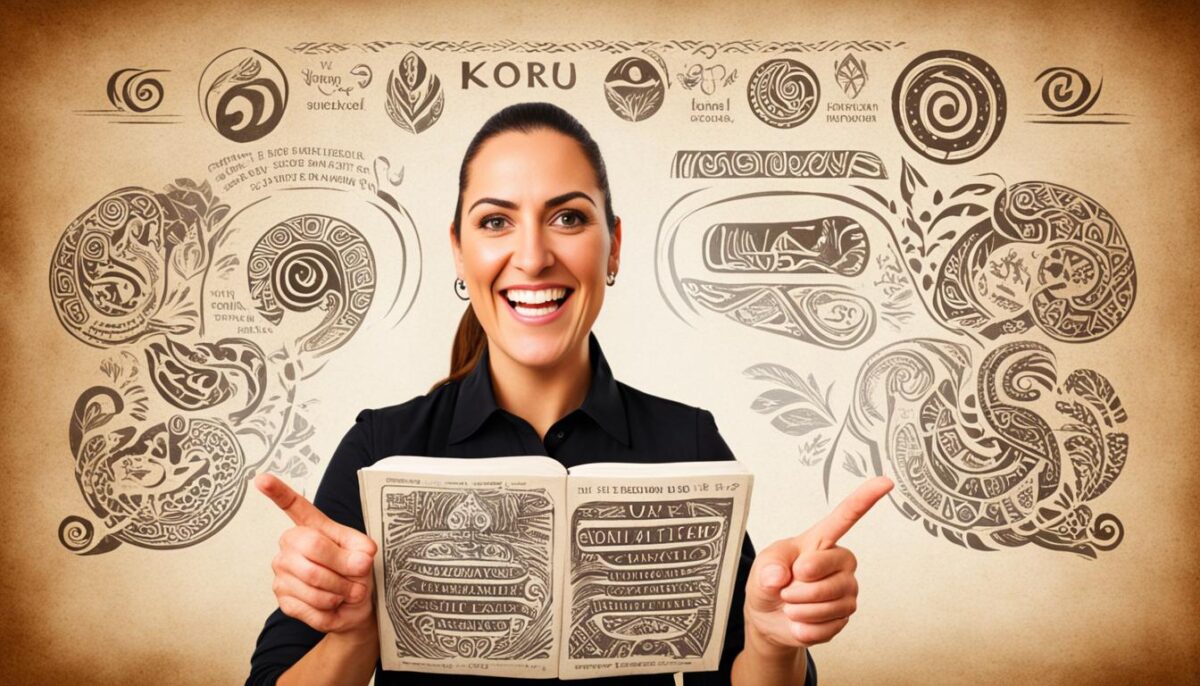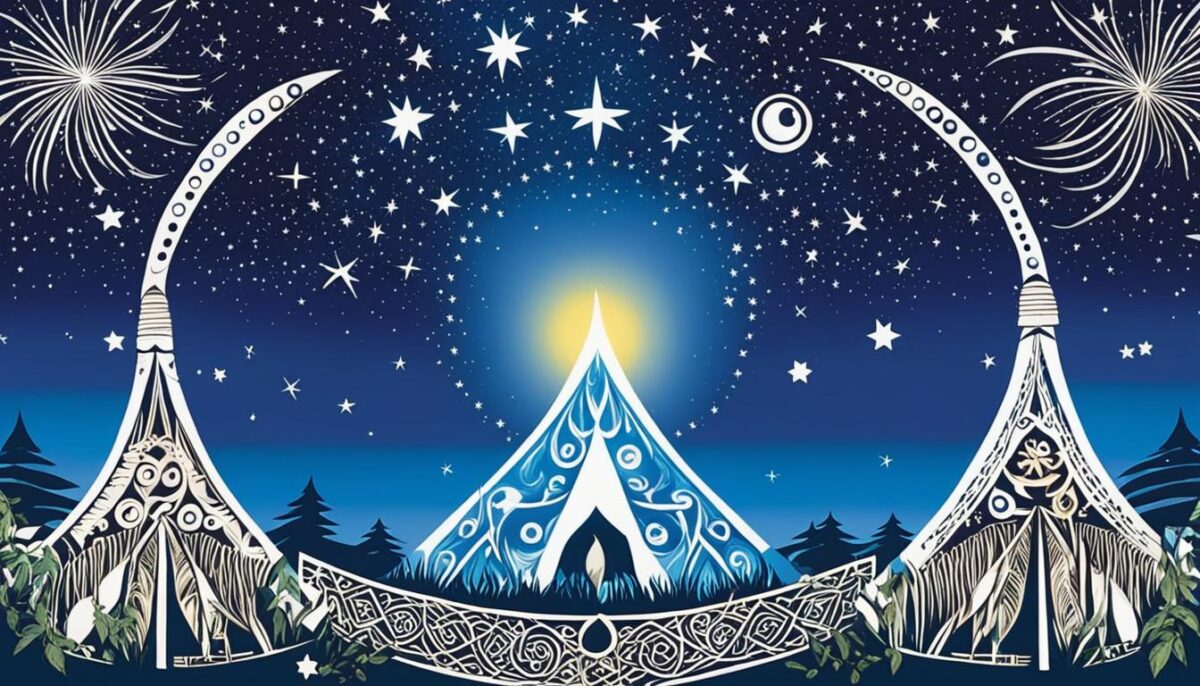Welcome to our guide on how to speak Maori, the indigenous language of New Zealand. Immerse yourself in the beauty of Maori culture and language as we take you on a journey of learning and discovery. Whether you’re planning a trip to New Zealand or simply want to expand your language skills, this guide will provide you with the tools and resources to learn Maori and communicate with the local people.

Visualize a person holding a Maori dictionary and pointing to a word while confidently speaking Maori. The background should feature symbols representative of Maori culture, like koru or manaia patterns. There should also be a sense of warmth and hospitality in the image, perhaps through the use of earthy tones and a welcoming facial expression on the person speaking Maori.
Maori is an official language of New Zealand and holds immense cultural significance. By learning Maori, you not only gain language proficiency but also deepen your understanding of the rich heritage and traditions of the Maori people. From basic pronunciation and vocabulary to building conversational skills, we will equip you with the knowledge and practice you need to confidently speak Maori.
Join us as we embark on a journey into the world of the Maori language and culture. Let’s begin our exploration and learn how to speak Maori!
The Basics of Maori Pronunciation and Vocabulary
In this section, we will delve into the fundamental aspects of Maori pronunciation and vocabulary. Understanding the pronunciation of Maori words plays a crucial role in developing fluency in the language. Additionally, building a solid foundation of essential Maori vocabulary will allow you to express yourself confidently in everyday conversations.
Let’s begin by exploring the unique sounds found in the Maori language. Maori pronunciation is characterized by a combination of familiar consonants and vowels, along with distinctive elongated sounds. To help you familiarize yourself with these sounds, we have compiled a list of common phonetic symbols used in Maori pronunciation:
| Phonetic Symbol | Maori Equivalent | Example |
|---|---|---|
| /a/ | a | aroha (love) |
| /e/ | e | whare (house) |
| /i/ | i | whiti (cross) |
| /o/ | o | motu (island) |
| /u/ | u | turangawaewae (ancestral home) |
Now that you are familiar with the pronunciation symbols, let’s explore some basic Maori phrases:
- Kia ora: Hello
- Tēnā koe: Thank you
- Kei te pēhea koe? How are you?
- Haere mai: Welcome
- Haere rā: Goodbye
Practice speaking these phrases aloud, paying attention to the pronunciation of each word. As you become more comfortable with the sounds of Maori, you can gradually expand your vocabulary and enhance your conversational skills.
Expand Your Vocabulary with Daily Practice
Learning Maori vocabulary is an essential part of mastering the language. Start by focusing on everyday words that you can incorporate into your daily conversations. Here are some common Maori words to get you started:
- Whānau: Family
- Kai: Food
- Rā: Sun/day
- Whare: House
- Manaakitanga: Hospitality
By practicing these words regularly, you will gradually build your Maori vocabulary and feel more confident in expressing yourself in the language.
In the next section, we will delve into constructing sentences and developing conversational skills in Maori. Building on the pronunciation and vocabulary knowledge you gained in this section, you will be able to engage in meaningful conversations and further enhance your language proficiency.
Building Sentences and Conversational Skills in Maori
In order to effectively communicate in Maori, it is essential to understand the structure of Maori sentences and practice constructing basic conversations. By mastering essential greetings, expressions, and conversation starters, you will be able to engage in simple interactions and express yourself confidently in Maori.
To begin, let’s explore the fundamental aspects of Maori sentence structure. Maori follows a different sentence structure compared to English, with the verb usually placed at the beginning or early in the sentence. This aspect is known as VSO (verb-subject-object) word order. For example:
Ko Te Aroha te ingoa o taku tamaiti.
(“Te Aroha is the name of my child.”)
Now, let’s move on to Maori greetings. Greetings play an essential role in Maori culture and are a great way to initiate conversations. Here are a few common Maori greetings:
- Kia ora – Hello
- Tēnā koe – Greetings to you (singular)
- Tēnā kōrua – Greetings to you two (two people)
- Tēnā koutou – Greetings to you all
Once you have greeted someone, you can continue the conversation with some simple phrases. Here are a few examples:
- Kei te pēhea koe? – How are you?
- Ko wai tō ingoa? – What is your name?
- Ko wai te whānau o ā koe? – Who is your family?
- Kei te pai – I’m good
As you gain confidence in constructing sentences and using greetings and phrases, you can start building basic conversations in Maori. Practice asking questions, introducing yourself, and engaging in simple exchanges. This will strengthen your conversational skills and help you feel more comfortable speaking Maori.
Remember to take small steps and practice regularly. By immersing yourself in Maori language and culture, you will develop a deeper connection with New Zealand’s indigenous heritage.
Now, let’s put everything into practice with an example conversation:
| English | Maori |
|---|---|
| Person A: Kia ora! Kei te pēhea koe? | Ki a A: Kia ora! Kei te pai ahau. Kei te pēhea koe? |
| Person B: Kei te pai ahau. Ko wai tō ingoa? | Ki a B: Kei te pai ahau. Ko [name] tōku ingoa. Kei te pēhea koe? |
| Person A: Kei te pai ahau. Ko [name] ahau. Kei te noho koe ki hea? | Ki a A: Kei te rawe ahau. Ko [name] ahau. Kei te noho ki [place] ahau. |

Show a visualization of Maori sentence structure using abstract shapes and patterns. Use a color scheme that represents the culture of Maori and incorporate organic elements like leaves or flowers to showcase the connection with nature. Add depth to the image by layering the shapes and patterns in a way that represents the different parts of a sentence.
Deepening Your Understanding of Maori Culture Through Language
As you embark on your journey of learning Maori, you’ll soon discover that it extends far beyond mere language acquisition. In fact, delving into the Maori language opens the door to a rich cultural tapestry, allowing you to gain deeper insights into Maori traditions and customs.
The Maori people have a profound connection to their language, which serves as a vessel for their culture, stories, and ancestral knowledge. By exploring Maori language learning, you’ll not only broaden your linguistic abilities but also develop a profound appreciation for New Zealand’s indigenous heritage.
Every word and phrase in the Maori language carries cultural significance, reflecting the values, beliefs, and history of the Maori people. Through your language journey, you’ll uncover the essence of Maori culture, experiencing its unique expressions, ancestral chants, and traditional practices firsthand.


